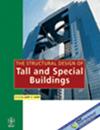基于滑模理论的建筑结构分散鲁棒控制
IF 1.3
3区 工程技术
Q3 CONSTRUCTION & BUILDING TECHNOLOGY
引用次数: 0
摘要
本文提出了一种分散控制算法,用于主动控制柔性高层建筑结构在地震作用下的响应。该方法将高层建筑结构以状态方程的形式划分为若干子结构。子系统与外界激励的相互作用以作用在子系统上的有界广义力的形式进行。基于滑模控制理论,建立了高层建筑结构的分散控制算法。基于单位矢量控制对控制结构进行了描述。控制律由两部分组成:线性控制律uL和非线性控制律uN。线性控制仅仅是一个线性状态反馈控制器,而非线性反馈控制器则包含了控制律的不连续或连续非线性元素。利用滑模理论的匹配条件和广义力的有界特性,研究了分散控制的整体稳定性。讨论了执行机构的布置和匹配条件。对20层基准结构在地震作用下的分散控制进行了数值模拟,验证了该方法的有效性。本文章由计算机程序翻译,如有差异,请以英文原文为准。
Decentralized robust control of building structures based on sliding mode theory
In this paper, a decentralized control algorithm is proposed for actively controlling the response of the flexible tall building structures under earthquake excitations. In the proposed approach, tall building structure was divided into some substructures in the form of state equation. The interaction of the subsystems and external excitations is conducted as bounded generalized force acting on the subsystems. A decentralized control algorithm of tall building structures is established based on the sliding model control theory. The control structure is described based on unit vector control. The control law consists of two parts: a linear control law uL and a nonlinear law uN. The linear control is merely a linear state feedback controller, whereas the nonlinear feedback controller incorporates the discontinuous or continuous nonlinear elements of the control law. Using the advantage of match conditions of sliding mode theory and the bounded feature of generalized force, the overall stability of decentralized control is also investigated. The actuator arrangement and matching conditions are discussed. The effectiveness of the proposed method is demonstrated by the numerical simulation of the decentralized control of a 20‐story benchmark structure under seismic excitations.
求助全文
通过发布文献求助,成功后即可免费获取论文全文。
去求助
来源期刊
CiteScore
5.30
自引率
4.20%
发文量
83
审稿时长
6-12 weeks
期刊介绍:
The Structural Design of Tall and Special Buildings provides structural engineers and contractors with a detailed written presentation of innovative structural engineering and construction practices for tall and special buildings. It also presents applied research on new materials or analysis methods that can directly benefit structural engineers involved in the design of tall and special buildings. The editor''s policy is to maintain a reasonable balance between papers from design engineers and from research workers so that the Journal will be useful to both groups. The problems in this field and their solutions are international in character and require a knowledge of several traditional disciplines and the Journal will reflect this.
The main subject of the Journal is the structural design and construction of tall and special buildings. The basic definition of a tall building, in the context of the Journal audience, is a structure that is equal to or greater than 50 meters (165 feet) in height, or 14 stories or greater. A special building is one with unique architectural or structural characteristics.
However, manuscripts dealing with chimneys, water towers, silos, cooling towers, and pools will generally not be considered for review. The journal will present papers on new innovative structural systems, materials and methods of analysis.

 求助内容:
求助内容: 应助结果提醒方式:
应助结果提醒方式:


